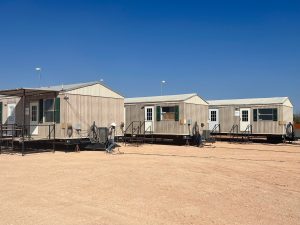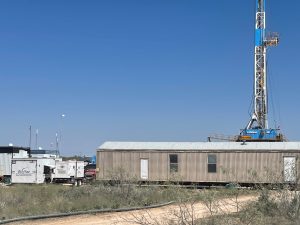By Paul Wiseman

Stellar Oilfield Rentals Leases out temporary housing on locations such as drilling sites and completion sites. Providing turnkey service, they also offer generators for power, communication equipment, and internet access, along with fresh and waste water management.
The wild swings of pricing in the oil and gas sector have brought turmoil to every part of that business, and equipment leasing is no exception. When drilling slows down, drillers need less equipment. So it goes for equipment companies like Gravity as well as those providing housing, such as Stellar Oilfield Rentals, LLC.
Chad Wolf, VP of Operations for Power & Rental for Gravity, says that upticks in oil prices have inflated pricing of everything else up and down the line. “Some of the things we’ve experienced in the last couple of years are associated with pricing.” The effects of that include both prices they charge for rentals and the amounts they pay for the equipment they lease out.
Unfortunately for the leasing industry, equipment costs have risen faster than leasing prices. During the downturn, rental rates plummeted due to lack of demand, and while rig counts are up by more than 200 year-over-year from 2021. Wolf said, “Some of the pricing of rental rates has not [returned to pre-pandemic levels] because there’s a fair amount of competition.”
The downside of higher oil prices is that diesel and motor oil also cost more, raising the expenses for transporting the heavy equipment Gravity leases out. The company’s top rental machinery includes natural gas-fired generators, drilling support equipment such as mud tanks, and pumps. Those items are tough to keep in stock, Wolf said.
He estimated that, in the Permian Basin, 40 percent of their rental business comes from drilling, with the other 60 percent coming from completions or production. The numbers vary from location to location. In the northern region including Colorado, Wyoming, and North Dakota, 80 percent of their business comes from production and completions.
Staffing is also a challenge, as is normal in the oil patch. After extensive layoffs, many of the suddenly unemployed decide to exit the industry for a more stable job scenario. Said Wolf, “It is a struggle to find, attract, and retain employees.” Some come to an interview and indicate a readiness to sign up, then it turns out they were only “checking a box on unemployment” and never intended to actually work. Others apply for several jobs and, after taking a job at Gravity, fail to show up because a job they prefer has come open.
The key, he believes, is to become as efficient as possible with the people they do have, while being careful “not to overwork them.”
Another form of efficiency involves considering labor intensity of each kind of equipment. “We’re even going as far as taking a hard look at the products that we offer—which ones are very labor-intensive and which ones are less labor intensive, and looking at focusing our efforts on those that are less labor-intensive.” Scaling back on geographic reach to reduce drive time is another consideration, involving costs for man hours for windshield time, as well as for fuel.
He cited large ranches in the Eagle Ford, where the ranch road’s speed limit is 25 MPH for dozens of miles, as a productivity drain.
For the rental sector, the widely-reported supply chain problems are combining with manpower shortages to create more delays in make-ready for rentals than is normal, he said.
Power generation equipment is one of the company’s top lines, and Wolf noted that, during the slowdown, clients were renting smaller horsepower units. “Whereas, when commodity prices increase, larger horsepower is in demand because our customers, those operators, want to get that product to market faster, which necessitates larger horsepower,” he said.

With yards serving the Permian Basin, in Midland, and in Marion, Texas, serving South Texas and the Eagle Ford, Stellar’s business is ramping up in both places-although the Permian Basin is leading the way.
As oil prices and overall inflation remain strong, many operators are looking for longer term leases to lock in today’s rental rates, Wolf said. It will not be a surprise to learn that Gravity takes the opposite view of lease lengths. As expenses continue to rise, lessors like Gravity’s leasing division know they’ll need to raise prices as quickly as possible to stay profitable.
Stellar Oilfield Rentals LLC Vice President J. Travis Williams agrees. The company leases out temporary housing on location such as drilling sites and completion sites. Providing turnkey service, they offer generators for power, communication equipment, and internet access, along with fresh and waste water management.
“Operators are always going to want the best pricing, and we strive to give the best pricing that we can, but the market’s dictating a lot of what we have to do as far as our transportation costs, employee labor costs, things like that. It’s just trying to maintain a balance and trying to maintain profitability while it’s ramping back up,” he said.
He noted that some of the larger companies were asking for contracts of up to a year, to lock in currently lower prices. “We’re generally pretty comfortable with six months, but at the same time, if we can evaluate that and know that we’re going to be okay with that, we certainly want to continue to provide service.”
With 2020’s negative pricing and stoppage of drilling, Stellar saw much of their inventory of trailers and equipment stack up in yards. Few locations were requiring onsite oilfield housing. Since the rebound started in 2021 and especially since the first of 2022, much more equipment has gone out than has come back, Williams said.
Now, “Our equipment is staying out longer because there’s consistent work again.” With yards serving the Permian Basin, in Midland, and in Marion, Texas, serving South Texas and the Eagle Ford, Stellar’s business is ramping up in both places—although the Permian Basin is leading the way.
But, as stated above, buying new equipment is getting costlier by the week. Williams cited one item in particular as a sort of bellwether for all equipment prices. “Generators are a pretty quick indicator to as to what the industry is doing because generator prices can go from from really cheap, to all-of-a-sudden you’ve got an extra $50 a day per generator to rent one out.”
After layoffs during the Pandemic, Stellar is also challenged with finding workers, especially CDL drivers to deliver and pick up trailers and to haul fresh and waste water. Said Williams, “I think if you had e a CDL, you could probably just throw a rock and hit a building and walk in and get a pretty good-paying job right now.”
Finding parts and equipment for both trucks and mobile homes can be a challenge, especially because of the industry they’re in. “Because we’re in the housing industry, when these trailers come back in we sometimes have to remodel/rebuild, so we’re dealing with supply chain issues that homebuilders would be dealing with.” That includes types and sizes of windows as well as more industry-standard supplies like truck and mechanical parts.
The supply issues for parts is further squeezed by the fact that trucks and trailers are also backlogged, meaning that the existing inventory must be repaired and maintained longer than normal, requiring more of those hard-to-find parts than usual.
For hospitality as well as other phases of the industry, downturn practices are coming back to haunt. “One of the other issues we’re dealing with—and I’ve read that, especially the drillers are dealing with too—is that, when all of this stuff downturned in 2020 to such an extreme degree, and a lot of equipment was stacked and parked—when you needed a part that was out in the field, you robbed it from” something that was stacked.
“It sounds kind of crazy, but we’ve got houses that have had doors pulled out of them, and washers, dryers, and stoves pulled out of them,” he said.
As those stored assets now are pressed into service, the robbed parts must be replaced. This is a much bigger job than mopping floors and replacing dishes and towels. “Refrigerators and appliances are hard to come by.
“It’s kind of an interesting time to try to navigate through.”
Interesting times make planning an interesting endeavor as well. “I’ve learned through a couple of these [downturns] not to predict too far out, because something like March, 2020 happens and all of a sudden you’re sitting there saying, ‘What in the world just happened?’”
“But at the current trend where things are at,” he continued, “what it looks like on the global market, I think we can expect to see, hopefully, prices stabilize and maintain.” He expects the rest of 2022 to be a busier time, assuming there are no further geopolitical earthquakes between now and December 31.
Equipment leasing allows E&Ps and others to reduce capex, while leasing companies expect that they can spin their large capital expenditures into profits as they relocate that equipment as needed. Oil price swings make planning a challenge for everyone, and the last two years have proven to be a greater challenge than almost any previous era in recent memory.










